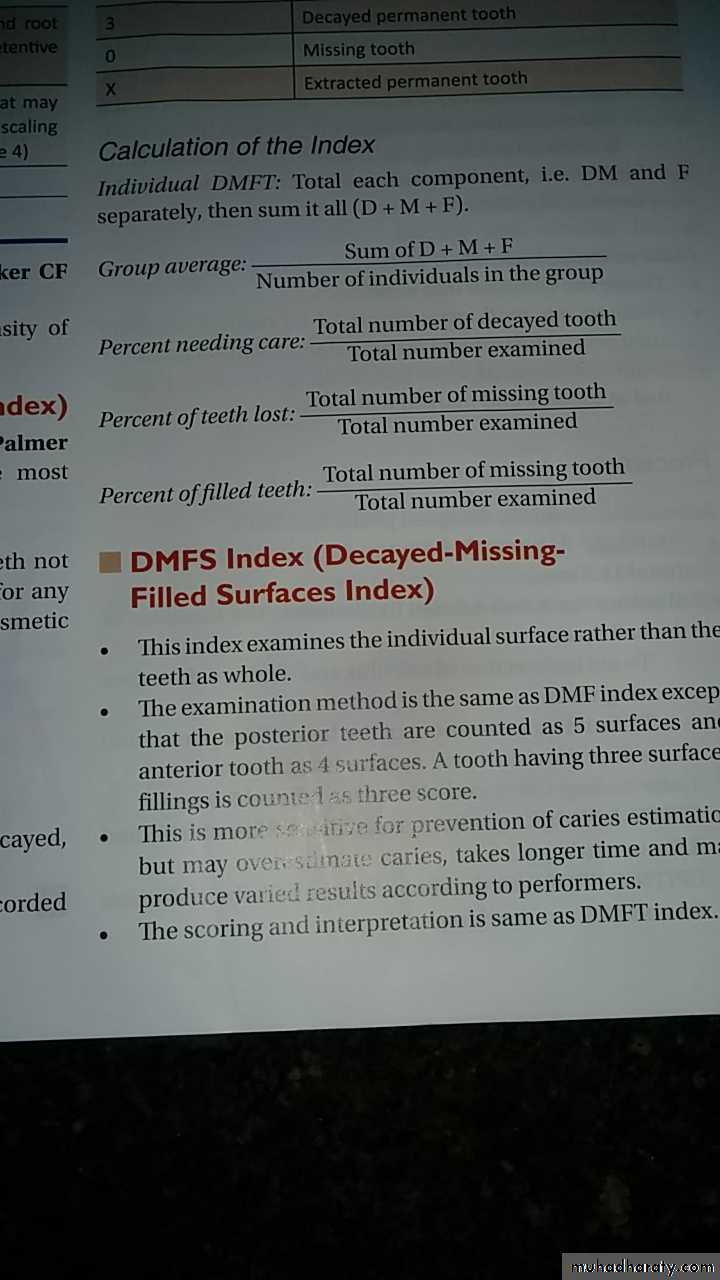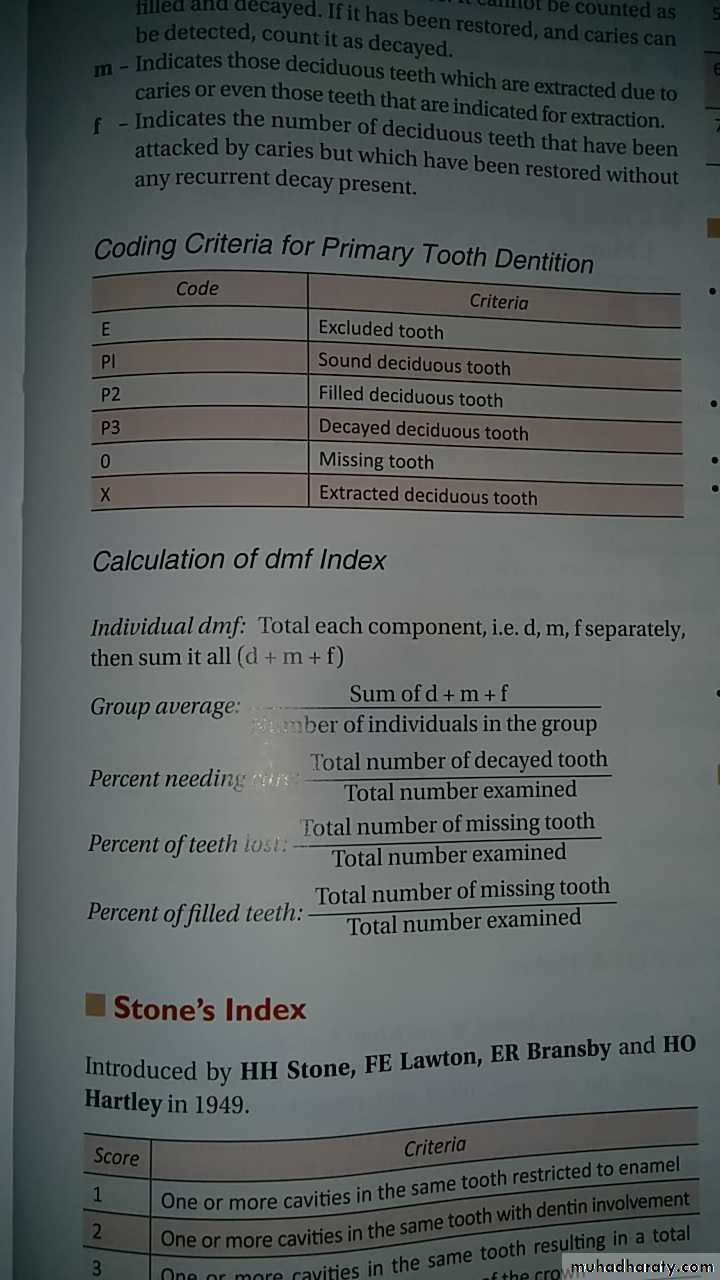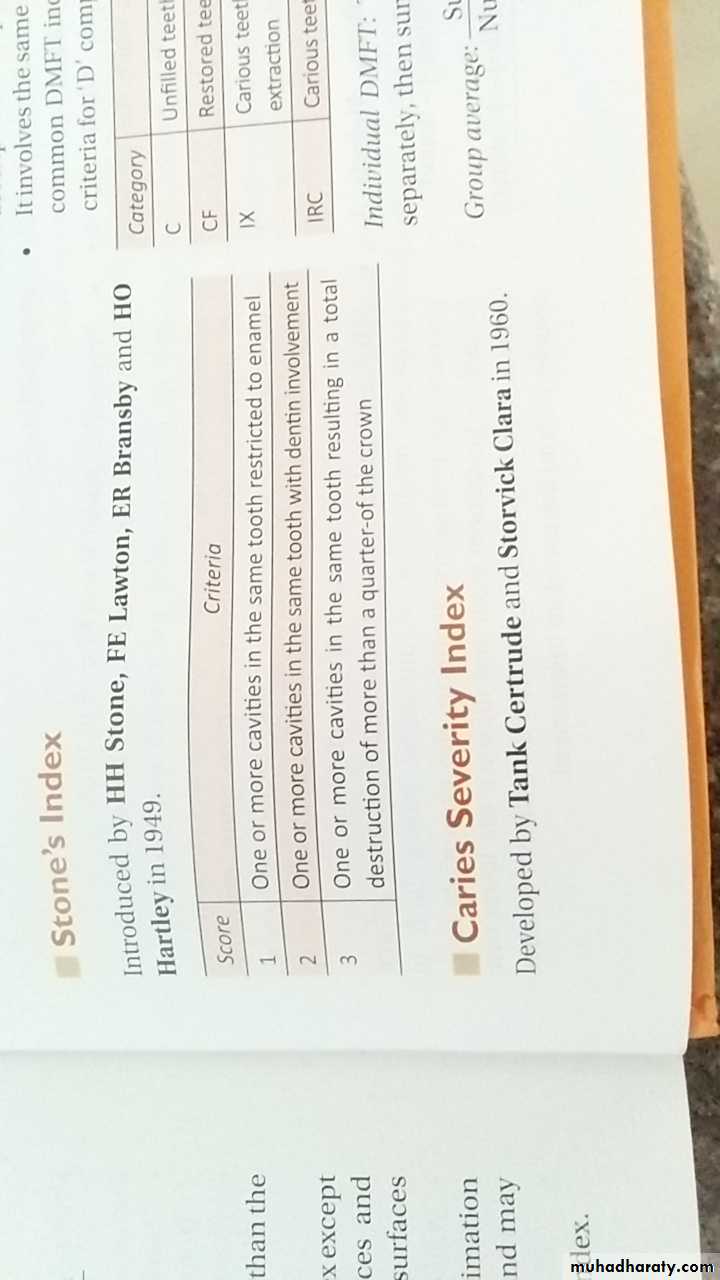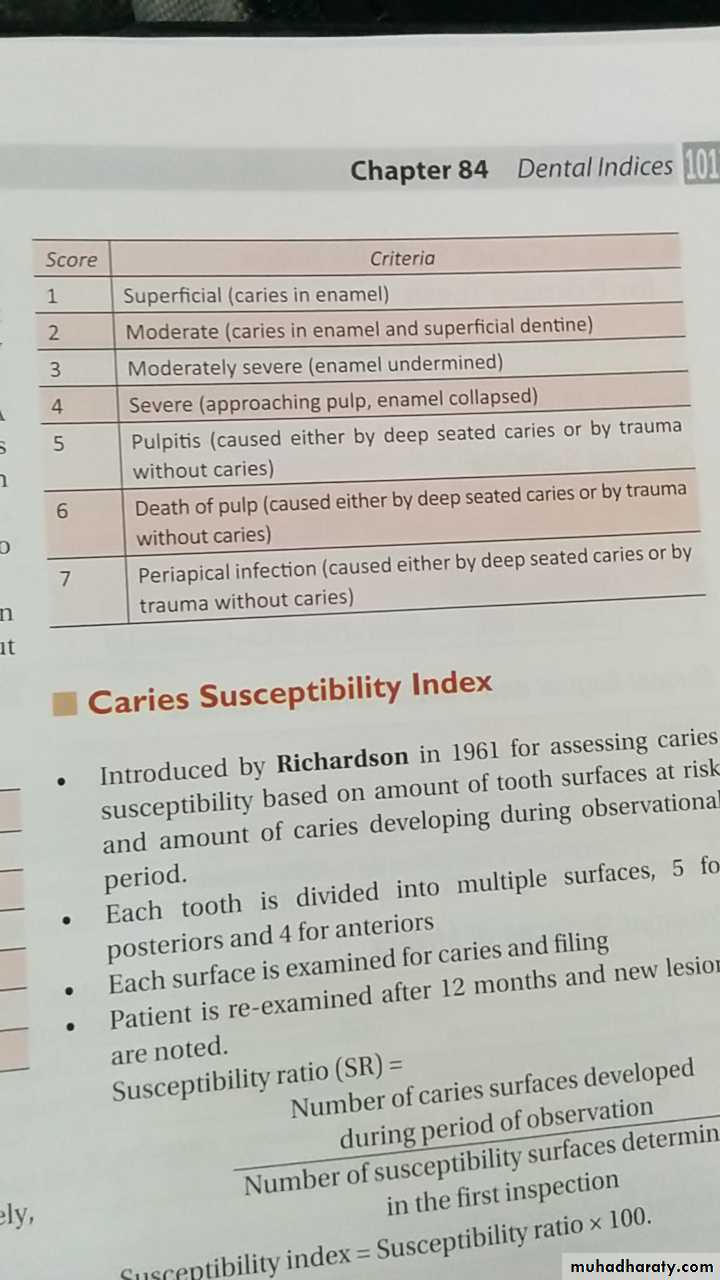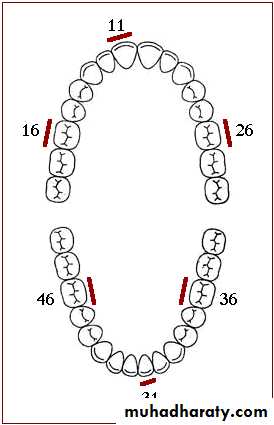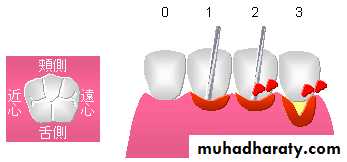Dental Indices
Used for recording oral diseases in children mainly dental caries, periodontal diseases, fluorosis and malocclusion1
Dr Hassan M. Dawood Al-Nuaimy
MSC Orthodontics
Definitions
Index is a graduated scale having upper and lower limits , with scores on the scale corresponding to specific criteria which is designed to permit and facilitate comparison with other population classified by same criteria and methods. – Russel ALEpidemiological indices are attempts to quantitate clinical condition on a graduated scale, thereby facilitating comparison among populations examined by the same criteria and methods. – Irving Glickman
2
Oral indices are essentially set of values, usually numerical with maximum and minimum limits, used to describe the variables or a specific conditions on a graduated scale, which use the same criteria and method to compare a specific variable in individuals, samples or populations with that same variables as is found in other individuals, samples or populations. – George P Barnes
3
Classification of index
Based upon the direction in which their scores can fluctuate(reversible and irr)Upon the extent to which the areas of oral cavity are measured(Full mouth…)
According to the entity they measure(Disease,symptoms, treatment)
General indices (simple, cumulative)
4
Requirement of an Index
• Clarity: understandable.
• Simplicity: easy to apply & understandable.
• Objectivity: should be clear and unambiguous.
• Validity: Must measure what it is intended to measure.
• Reliability: Should measure consistently at different times (reproducible).
2 components-
Inter examiner reliability: different examiners record the same result.
Intra examiner reliability: same examiner records the same result at repeated attempts.
• Sensitivity: Ability to distinguish between small increments.
• Acceptability: Safe and no pain to the subject.
• Quantifiability: The index should be amenable to statistical analysis and interpretable.
5
Caries Indices
• DMFT• DMFS
• def
• dmf
• Stone’s Index
• Caries severity index
6
DMFT Index
Also Known as Klein and Palmer index in 1938.
Measure the surface caries, incidence not severity.
Only permanent teeth ,28 teeth are included, 3rd molar excluded.
D=decayed, M=Missing, F=Filled.
For a community, Sum of D+M+F of individuals/ number of individual.
7
Features of DMFT
Tooth is counted only onceDecayed, missing and filled teeth should be recorded separately
Recurrent caries is also counted as decay
Extraction indicated teeth are included in missing
Many restoration is counted as one score
8
9
Limitations
DMFT values are not related to the number of teeth at risk
Can be invalid in older patients because teeth can become lost for reasons other than caries
Can be misleading in children whose teeth lost due to orthodontic reasons
Can overestimate caries experience in teeth in which preventive filling have been placed
Little use in root caries
10
Modification is DMFS
DMFS measures the number of affected SURFACES instead of teeth.5 surfaces can be measured.
MESIAL, DISTAL, OCCLUSAL, BUCCAL, LINGUAL OR PALATAL.
Finer measurement than DMFT.
Each tooth had 5 points.
11
def Index
Gruebbel AD 1944 as an equivalent index to DMF for measuring dental caries in primary dentitiond – deciduous teeth decayed indicated for filling.
e – deciduous teeth decayed indicated for extraction.
f – Indicates restored teeth without recurrent decay.
Missing teeth for any reasons are not recorded.
12
dmf index by Jackson.
In order to count the number of teeth that are lost due to cariesProblem is to know whether the missing tooth is due to caries or normally exfoliated.
Jackson suggest:
For full mouth :3-5.
For molars : 3-8.
WHO recommended that missing teeth are disregarded after 9 years of age only recorded as missing under this age if normal shed would not be sufficient explanation for absence.
13
14
Stone’s Index
Introduced by HH Stone, FE Lawton, ER Bransby and HO Hartley in 194915
Caries Severity Index
Tank Certrude and Storvick Clara 196016
INDICES USED FOR ORAL HYGIENE ASSESSMENT
ORAL HYGIENE INDEXSIMPLIFIED ORAL HYGIENE INDEX
PATIENT HYGIENE PERFORMANCEWHO system
17ORAL HYGIENE INDEX (OHI)
Developed in 1960Green and Vermillion in order to classify and assess oral hygiene status.
Simple and sensitive method for assessing group or individual oral hygiene quantitatively.
It is composed of 2 components:
Debris index (DI)
Calculus index (CI)
18
19
RULES OF ORAL HYGIENE INDEX
1Only fully erupted permanent teeth are scored.
2
• The buccal and lingual debris scores are both taken on the tooth in a segment having the greatest surface area covered by debris.
3
• The buccal and lingual calculus scores are both taken on the tooth in a segment having the greatest surface area covered by supragingival and subgingival calculus.
4
• Maximum score= 3*6 segments=18*2(buccal and lingual)=36 is the maximum score
• Then divided by 6 thus the maximum score is 6.
20
0 – no debris or stain
present1 – soft debris covering
not more than 1/3rd the
tooth surface, or presence
of extrinsic stains without
other debris regardless
of the area covered
2 – soft debris covering
more than 1/3rd, but not
more than 2/3rd,of the
exposed tooth surface
3 – soft debris covering more
than 2/3rd of the exposed
tooth surface
DEBRIS INDEX
21
SCORE
CRITERIA0
No calculus present
1
Supragingival calculus covering not more than 1/3 of the exposed tooth surface
2
Supragingival calculus covering more than 1/3 but not more than 2/3 the exposed tooth surface or presence of individual flecks of subgingival calculus around the cervical portion of the tooth or both.
3
Supragingival calculus covering more than 2/3 the exposed tooth surface or a continuous heavy band of subgingival calculus around the cervical portion of tooth or both.
Supragingival
calculus
Subgingival
calculus
CALCULUS INDEX
Calculation
OHI = DI + CI
DI and CI range from 0-6
Maximum score for all segments can be 36 for debris or calculus
OHI range from 0-12
Higher the OHI, poorer is the oral hygiene of patient
22
SIMPLIFIED ORAL HYGIENE INDEX
John C Greene and Jack R Vermillion in 1964.Only fully erupted permanent teeth are scored.
Natural teeth with full crown restorations and surfaces reduced in height by caries or trauma are not scored.An alternate tooth is then examined.
2324
16
17,18
11
21
26
27,28
36
37,38
31
41
46
47,48
Calculation and Interpretation
OHI -S= DI-S+ CI-SDI-S and CI-S range from 0-3
OHI-S range from 0-625
INTERPRETATION
DI –S and CI-S
Good -0.0-0.6
Fair – 0.7-1.8Poor – 1.9 -3.0
OHI –S
Good - 0.0-1.2Fair – 1.3- 3.0
Poor – 3.0 -6.0
Uses
Widely used in epidemiological studies of periodontal diseases.Useful in evaluation of dental health education programs
Evaluating the efficacy of tooth brushes.Evaluate an individual’s level of oral cleanliness.
26PATIENT HYGIENE PERFORMANCE (PHP INDEX)
Introduced by Podshadley A.G. and Haley J.V in 1968.
Assessments are based on 6 index teeth.
The extent of plaque and debris over a tooth surface was determined.
27
16
buccal
11
labial
26
buccal
36
lingual
31
labial
46
lingual
PROCEDURE:
Apply a disclosing agent before scoring.Patient is asked to swish for 30 sec and then expectorate but not rinse.
Examination is made by using a mouth mirror.
Each of the 5 subdivisions is scored for presence of stained debris:
0= no debris(or questionable)
1= debris definitely present.
28
M
MI
D
M
O/I
G
Debris score for individual tooth:
Add the scores for each of the 5 subdivisions.PHP index for an individual :
Total score for all the teeth divided by the number of teeth examined.RATING SCORES:
Excellent : 0 (no debris)Good : 0.1-1.7
Fair : 1.8 – 3.4
Poor : 3.5 – 5.0
29
Debris score
for 1 tooth = 4/5
= 0.8
1
1
1
1
0
Who system
It is simple prevelance index.The teeth are not dried or stained , and no probe is used.
The mouth is divided into 6 segments, posterior right and left and anterior in each jaw.
All surfaces of each segment are examined and each segment is scored as one unit.
Maximum score for individual is 6.
Criteria for WHO:
0: No soft deposit visible.
1: any soft deposit on any surface clearly visible by the naked eye.
30
Plaque index
Loe and Silness in 1964Assesses the thickness of plaque at the cervical margin of the tooth closest to the gums
All four surfaces are examined
Distal
Mesial
Lingual
Buccal
31
12
24
16
44
32
36
Scoring Criteria
ScoreCriteria
0
No Plaque
1
A film of plaque adhering to the free gingival margin and adjacent area of tooth the plaque may be seen in situ only after application of disclosing solution or by using probe on tooth surface
2
Moderate accumulation of soft deposits within the gingival pocket, or the tooth and gingival margin which can be seen with the naked eye
3
Abundance of soft matter within the gingival pocket and/or on the tooth and gingival margin
32
Calculation
Plaque index for area : 0-3 for each surface.Plaque index for a tooth : Scores added and then divided by four.
Plaque index for group of teeth : Scores for individual teeth are added and then divided by number of teeth.
Plaque index for the individual : Indices for each of the teeth are added and then divided by the total number of teeth examined.
Plaque index for group : All indices are taken and divided by number of individual
33
Interpretation of Plaque index
Rating
Scores
Excellent
0
Good
0.1-0.9
Fair
1.0-1.9
Poor
2.0-3.0
34
• Gingival indices
• Gingival index• WHO system for ginigival health
35
Gingival Index
Developed by Loe H and Silness J in 1963.One of the most widely accepted and used gingival indices.
Assess the severity of gingivitis and its location in 4 possible areas.
Mesial
Lingual
Distal
Facial
Only qualitative changes are assessed.
36
METHOD:
All surfaces of all teeth or selected teeth or selected surface of all teeth or selected teeth are scored.The selected teeth as the index teeth are 16,12,24,36,32,44.
The teeth and gingiva are first dried with a blast of air and/or cotton rolls.
The tissues are divided into 4 gingival scoring units: disto facial papilla, facial margin, mesio facial papilla and entire lingual margin.
A blunt periodontal probe is used to assess the bleeding potential of the tissues.
37
38
SCORE
CRITERIA
0
Absence of inflammation/normal gingiva
1
Mild inflammation, slight change in color, slight edema, no bleeding on probing
2
Moderate inflammation, moderate glazing, redness, edema and hypertrophy. bleeding on probing
3
Severe inflammation, marked redness and hypertrophy ulceration. Tendency to spontaneous bleeding.
Calculation and Interpretation
If the scores around each tooth are totaled and divided by the number of surfaces per tooth examined (4), the gingival index score for the tooth is obtained.Totaling all of the scores per tooth and dividing by the number of teeth examined provides the gingival index score for individual.
Interpretation:
0.1 - 1.0 : Mild gingivitis
1.1 – 2.0 : Moderate gingivitis
2.1 – 3.0 : Severe gingivitis
39
WHO system for ginigival health:
It is simple prevelance index.The teeth are not dried or stained , and no probe is used.
The mouth is divided into 6 segments, posterior right and left and anterior in each jaw.
All surfaces of each segment are examined and each segment is scored as one unit.
Maximum score for individual is 6.
Criteria for WHO:
0: when there is no or only minor alteration in gingival colour and form, and no bleeding after digital palpation.
1: when there is marked change in colour, bleeding or firm digital palpation and marked general loss of stippling.
40
Thank you
41

